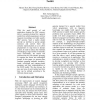Free Online Productivity Tools
i2Speak
i2Symbol
i2OCR
iTex2Img
iWeb2Print
iWeb2Shot
i2Type
iPdf2Split
iPdf2Merge
i2Bopomofo
i2Arabic
i2Style
i2Image
i2PDF
iLatex2Rtf
Sci2ools
COLING
2002
2002
Automatic Semantic Grouping in a Spoken Language User Interface Toolkit
With the rapid growth of real application domains for NLP systems, there is a genuine demand for a general toolkit from which programmers with no linguistic knowledge can build specific NLP systems. Such a toolkit should provide an interface to accept sample sentences and convert them into semantic representations so as to allow programmers to map them to domain actions. In order to reduce the workload of managing a large number of semantic forms individually, the toolkit will perform what we call semantic grouping to organize the forms into meaningful groups. In this paper, we present three semantic grouping methods: similaritybased, verb-based and category-based grouping, and their implementation in the SLUI toolkit. We also discuss the pros and cons of each method and how they can be utilized according to the different domain needs.
| Added | 17 Dec 2010 |
| Updated | 17 Dec 2010 |
| Type | Journal |
| Year | 2002 |
| Where | COLING |
| Authors | Hassan Alam, Hua Cheng, Rachmat Hartono, Aman Kumar, Paul Llido, Crystal Nakatsu, Huy Nguyen, Fuad Rahman, Yuliya Tarnikova, Timotius Tjahjadi, Che Wilcox |
Comments (0)

